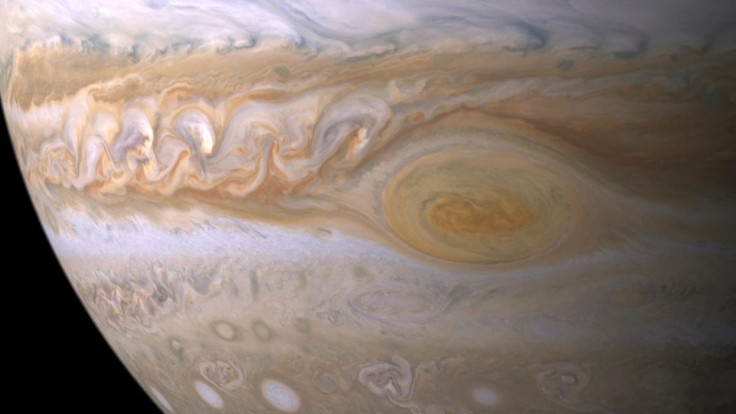Does Jupiter Have Water? Great Red Spot Shows Traces Deep Inside

The birth and evolution of Jupiter have long been debated. Some think the gas giant, which weighs as much as 300 Earths, used left-over elements from a newborn sun and formed as its all gaseous close relative, while others posit it came into existence with a core of rock and water ice and later drew gases from the solar nebula to make up the massive atmosphere we see today — going thousands of miles deep.
The chemical data taken from different missions as well as the observed gravitational pull of Jupiter has bolstered support for the second case. However, in order to confirm the presence of a core like that and understand the birth of solar system’s biggest planet, scientists needed to find traces of water, which is exactly what a group of researchers from NASA just accomplished.
“The moons that orbit Jupiter are mostly water ice, so the whole neighborhood has plenty of water,” Gordon L. Bjoraker, a NASA astrophysicist and one of the authors of the work, said in a statement. “Why wouldn't the planet — which is this huge gravity well, where everything falls into it — be water-rich, too?”
To solve the mystery, Bjoraker and colleagues looked at Jupiter’s Great Red Spot, a persistent high-pressure region in the atmosphere, producing a storm south of the planet's equator. They analyzed data related to thermal radiation leaking from the depths of the storm, collected by the W.M. Keck Observatory in Hawaii and NASA Infrared Telescope Facility, and used that information to detect the gases prevailing at different altitudes.
Among the identified gases, they focused on the strength of methane, which should be abundant in all regions of Jupiter due to its heat.
“If you see that the strength of methane lines vary from inside to outside of the Great Red Spot, it's not because there's more methane here than there,” Bjoraker added, “it's because there are thicker, deep clouds that are blocking the radiation in the Great Red Spot.”
This revealed three layers of clouds in the Great Red Spot as well as the conditions prevailing there, just as the team expected. Most importantly, the deepest layer of cloud had a pressure of around five bars, which is exactly where the temperature is around the freezing point for water. This indicated the presence of water cloud deep within the planet’s atmosphere.
On combining the pressure of water noted in the study as well as the strength of carbon monoxide, the team concluded Jupiter carries two to nine times more oxygen than the sun and was likely to be rich in water, at least in the deepest parts regions.
“Jupiter’s water abundance will tell us a lot about how the giant planet formed, but only if we can figure out how much water there is in the entire planet,” Steven M. Levin, a project scientist for NASA’s Juno spacecraft, added in the statement.
The observations taken by Juno could verify the latest findings, proving the model could use the same technique to map water abundance not just on other parts of Jupiter but also on other gas giants including Saturn and Uranus.
The study titled, "The Gas Composition and Deep Cloud Structure of Jupiter's Great Red Spot," was published in the Astronomical Journal.
© Copyright IBTimes 2024. All rights reserved.





















